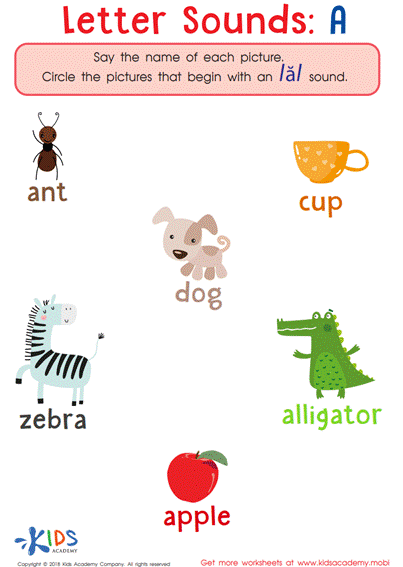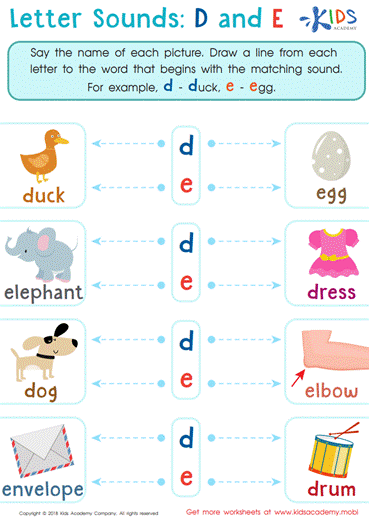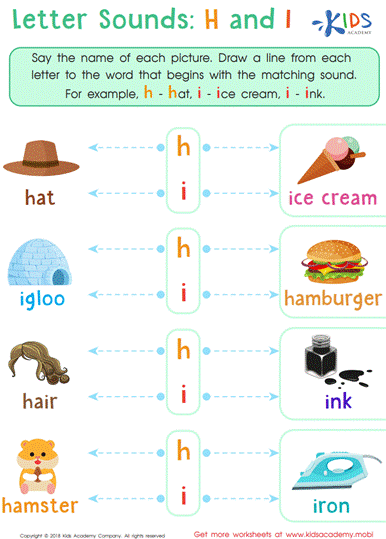-
English
-
English Pre-K
-
Unit 1: Early Literacy Skills
-
ABCs
- Pre-writing Activities
- Letter A
- Letter B
- Letter C
- Letter D
- Letter E
- Letter F
- Letter G
- Letter H
- Letter I
- Letter J
- Letter K
- Letter L
- Letter M
- Letter N
- Letter O
- Letter P
- Letter Q
- Letter R
- Letter S
- Letter T
- Letter U
- Letter V
- Letter W
- Letter X
- Letter Y
- Letter Z
-
Phonological Awareness
- Rhyming Words
- Letter Sounds B, C, D, and F
- Letter Sounds G, H, J, and K
- Letter Sounds L, M, N, and P
- Letter Sounds Q, R, S, and T
- Letter Sounds V, W, X, Y, and Z
- Letter Sounds A, E, and I
- Letter Sounds O and U
- Beginning Sounds
- Matching Letters to Sounds
-
ABCs
-
Unit 2: Vocabulary
-
Common Words
- Sorting Words into Categories
- Color Words
- Verbs and Adjectives
-
Sight Words
- Sight Words 'I' and 'Can'
- Sight Words 'You' and 'Like'
-
Common Words
-
Unit 3: Print Awareness
-
Parts of a Book
- Working with a Book
- Spaces Between Words
- Text and Illustrations
-
Picture Books and Poems
- Picture Book Text Features
- Poem Text Features
- Signs and Labels in the Community
-
Parts of a Book
-
Unit 4: Reading Literature
- Questions About Stories
- Discussing Stories
-
Unit 5: Reading Informational Texts
- Retelling Details in a Text
- Questions About a Text
- Connections Between Events
- Text Features
- Describing Illustrations
-
Unit 1: Early Literacy Skills
-
English Pre-K
-
Math
-
Math for Pre-Kindergarten
-
Logic and Geometry
-
Matching and Sorting
- Same and Different
- Which One Is a Little Different?
- Objects That Go Together
- Sorting by Color and Size
- Sorting The Same Group in Different Ways
- Patterns
-
Shapes
- Shapes in Our Environment
- Naming Shapes Regardless of Size
- Making Shapes in Preschool
- Comparing Shapes
- Relative Positions
- Sorting Shapes
-
Matching and Sorting
-
Early Number Sense
-
Numbers 1–5
- Counting to 3
- Counting to 5
- Arranging Objects up to 3 Objects
- Arranging up to 5 Objects
- Writing Numbers 1–5
-
Numbers 1–5
-
Numbers up to 10
- Counting to 10
- Arranging up to 10 Objects
- Number 0
- Writing Numbers 6–10
- Breaking Down Numbers 6-10
-
Logic and Geometry
-
Math for Pre-Kindergarten
Teaching Letter Sounds A, E and I to a Preschooler
Phonological awareness, the foundation of learning how to read and write, consists of learning not only consonants, but also vowel sounds. Almost all English words need at least one vowel sound, thus vowels are key to learning language skills. The English alphabet has 5 vowel letters: A, E, I, O, and U. Each of these vowels can produce several sounds. For the preschool level, it is easier to teach children one sound at a time, mainly the short vowel sounds. This article tackles the three letter sounds—A, E and I—focusing on the short sounds they produce in the initial position. You will also find activities to help you teach your child these vowel sounds.
Letter Sound A
The letter A is the first letter in the alphabet, and the first vowel sound. It makes a short /ă/ as an initial sound, such as in the word “apple”. A simple activity you can offer your child is to have them listen to you saying words and identify if each starts with the letter sound A or not. To make it fun, tell them to say “aaaaaaa” as loud as they can when a word starts with the letter sound A.
Another activity you can prepare for your child is this fun and easy worksheet titled “Letter Sounds: A” from the Kids Academy website. In this sheet, your blossoming reader will identify the short /ă/ sound in familiar words. They'll use the picture clues to say the name of each word and then practice their fine-motor skills as they trace a circle around pictures that begin with the /ă/ sound.
Letter Sound E
The letter E produces the short /ĕ/ as in the word “elephant”. Prepare this letter sound E activity to help your child learn the sound seamlessly: in a sensory bin, add an eraser, a miniature toy elephant, a boiled or fake egg, an envelope, and an image of an elbow. Then add some more random objects that do not start with an E. On the side, put two small containers in which your child has to sort the objects into ones that start with the vowel sound /ĕ/ and ones that don’t.
In addition, you can offer this “Letter Sounds: D and E” worksheet from Kids Academy where your child will identify the names of the images in order to match them to their corresponding beginning sounds. This sheet offers children the opportunity to work on their phonological awareness skills as they differentiate between the two letter sounds, D and E.
Letter Sound I
At the beginning of words, the letter I can produce two different sounds: short /ĭ/ like in “igloo”, and the long /ī/ like in “ice cream”. To help your child differentiate between these two initial sounds, set up this activity where you tell them words, part of which start with a short /ĭ/ sound (inch, India, Italy, ink, itch, info, image, etc.), and the other part starts with a long /ī/ sound (ice, iron, idea, ivy, item, iris, icon etc.). All they have to do is listen intently and identify what sound each word starts with. If the word starts with a short /ĭ/, they should squat, and if it starts with a long /ī/, they should jump and put their hands as high as they can. This activity not only works on their phonological skills, but also puts in some movement in their day, and some fun!
To wind the little learners down, you can also offer this “Letter Sounds: H and I” worksheet from Kids Academy.
The activities above are a great way to help your child learn the three vowel sounds. To assess how well your child retained this newly acquired information, prepare the following activity: cut out a paper triangle, and write one vowel sound on each of its sides. Place a long object in the middle, like a pencil, and spin it. Then take turns with your child in saying words that start with the letter sound the tip of the pencil ends up pointing towards. Use our interactive catalogue to find more articles on different aspects of phonological awareness.




